If you’re a responsible pet owner, you know that dental hygiene is vital for your dog’s overall health and well-being. However, brushing your dog’s teeth can be a challenging task, especially if your furry friend is uncooperative or fearful. In this comprehensive guide, we’ll provide you with step-by-step instructions on how to train your dog to brush their teeth easily, making the process enjoyable for both of you.
- Training your dog to brush their teeth is crucial for maintaining their dental hygiene and overall well-being.
- Introducing your dog to the toothbrushing process is the initial step in training.
- Choosing the right toothbrush and toothpaste for your dog is essential for effective dental care.
- Positive reinforcement techniques are key to successful training.
- Consistency in dental care routine and regular veterinary check-ups are vital for preventing dental issues.
Why is Dental Hygiene Important for Dogs?
Dental hygiene is just as important for dogs as it is for humans. Neglecting your dog’s dental care can lead to a host of health issues, such as gum disease, tooth decay, and bad breath. Dental hygiene for dogs is essential for their overall health and well-being.
According to the American Veterinary Medical Association, 80% of dogs show signs of oral disease by the age of three. This makes dental care training a crucial component of your dog’s overall healthcare regimen. A regular oral care routine can prevent serious health issues and ensure your furry friend has a healthy and happy life.
To provide the best dental care for your dog, it is essential to have a good understanding of their dental structure. Dogs have 42 teeth compared to humans’ 32, and their teeth are designed to rip and chew food. It is important to bear this in mind when choosing dental care products for your pet.
| Why is dental hygiene important? | Benefits of dental care |
|---|---|
| – Prevents plaque and tartar buildup | – Fresh breath |
| – Prevents gum disease and tooth decay | – Reduces risk of serious health issues |
| – Maintains healthy teeth and gums | – Saves money on costly dental procedures |
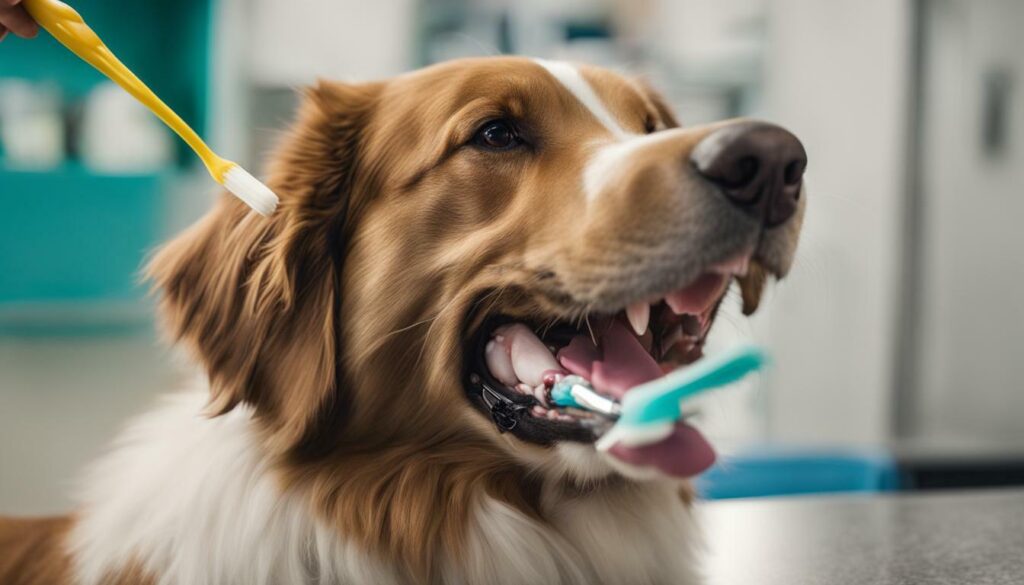
Dog dental care training should become a part of your pet’s daily routine to keep their teeth healthy and prevent dental issues. By regularly brushing your dog’s teeth and ensuring they receive regular veterinary checkups, you can maintain their dental hygiene, keeping them happy and healthy for years to come.
Introducing Your Dog to Toothbrushing
Teaching your dog to brush their teeth can be a challenging task, but with patience and consistency, it can become a positive routine for both you and your furry friend. Introducing your dog to toothbrushing is the first step in the training process.
Before starting the training, ensure that your dog is comfortable with having their mouth handled. Touch their lips, gums, and teeth gently with your finger while praising and rewarding them with treats. This will help them get used to the sensation and create a positive association with mouth handling.
Once your dog is comfortable with mouth handling, it’s time to introduce them to the toothbrush. Start by showing your dog the toothbrush and allowing them to sniff and investigate it. Praise and reward them with treats for showing interest.
Next, dab a small amount of dog toothpaste on the toothbrush and allow your dog to lick it off. This will help them get familiar with the taste and texture of the toothpaste.
When your dog is comfortable with the toothbrush and toothpaste, it’s time to start brushing their teeth. Begin by gently lifting your dog’s lip to expose their teeth. Using a circular motion, brush the outer surfaces of their teeth. Be gentle and patient, praising and rewarding your dog throughout the process.
It’s important to start slow and gradually increase the duration of each brushing session as your dog becomes more comfortable with the process. With consistent training, your dog will learn to enjoy toothbrushing and look forward to their daily dental care routine.
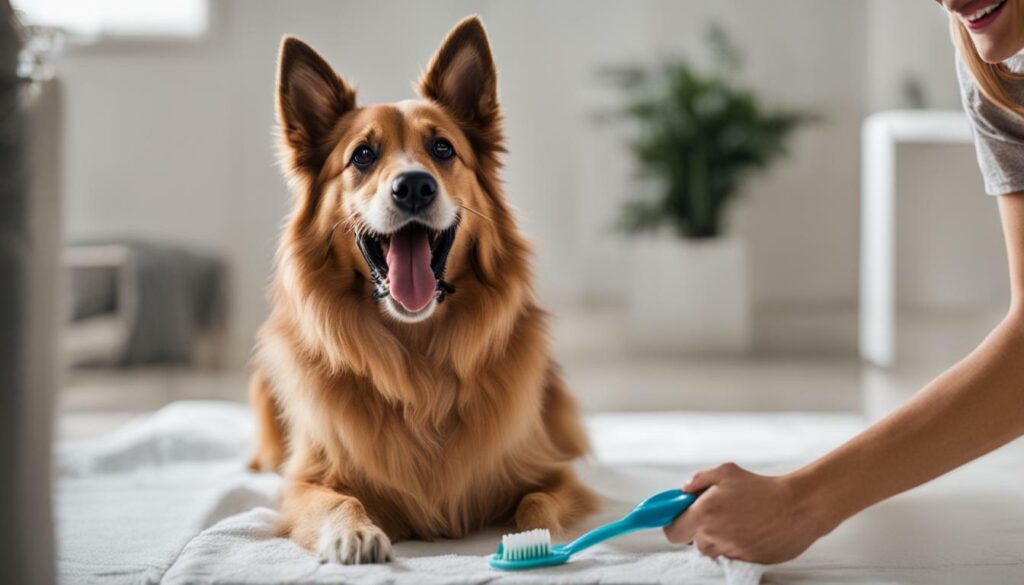
- Start by getting your dog comfortable with mouth handling
- Show your dog the toothbrush and allow them to sniff and investigate it
- Dab a small amount of dog toothpaste on the toothbrush and allow your dog to lick it off
- Be patient and start slow, gradually increasing the duration of each brushing session
- Praise and reward your dog throughout the process to create a positive association with toothbrushing
Choosing the Right Toothbrush and Toothpaste for Your Dog
Choosing the right toothbrush and toothpaste is crucial for effectively cleaning your dog’s teeth.
For toothbrushes, select a soft-bristled brush designed specifically for dogs, as harder bristles can irritate their gums. Additionally, choose a brush that fits comfortably in your hand and has a long handle to reach all areas of your dog’s mouth.
There are also several types of toothpaste specifically formulated for dogs, including beef, chicken, and peanut butter flavors. Avoid using human toothpaste, as it contains ingredients that can be harmful to dogs.
Once you have selected the appropriate toothbrush and toothpaste, allow your dog to sniff and taste them. This will help them become familiar with the products and create a positive association.
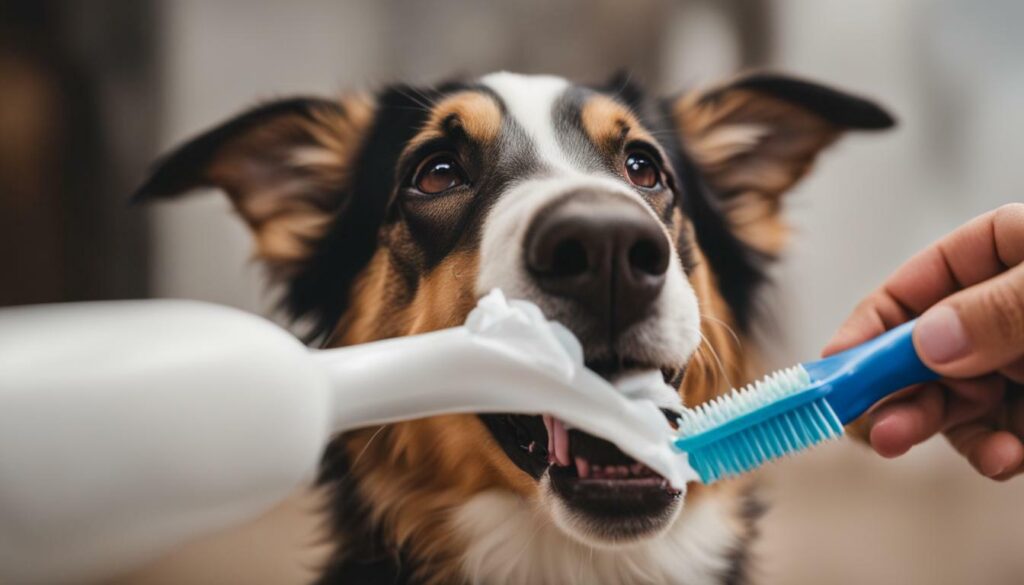
As you begin training your dog to brush their teeth, always use positive reinforcement techniques, such as praise and treats, to make toothbrushing a positive experience for your furry friend.
Getting Your Dog Comfortable with Toothbrush Handling
One of the biggest challenges in training your dog to brush their teeth is getting them comfortable with the toothbrush handling. Many dogs are resistant to having their mouths touched or pried open. Here are some tips to help you acclimate your dog to toothbrush handling.
Start Slowly and Introduce Gradually
The first step in training your dog to brush their teeth is to introduce them to the toothbrush handling. Start slowly by letting your dog get familiar with the toothbrush. Place a small amount of toothpaste on the brush and allow your dog to smell and lick it. Gradually move the toothbrush closer to your dog’s mouth, and touch it against their lips and gums.
Positive Reinforcement
Using positive reinforcement techniques can make a huge difference in getting your dog comfortable with toothbrush handling. Treats, toys, and praise can help encourage your dog to associate the toothbrush with positive experiences. Reward your dog for allowing you to touch their mouth and praise them for their cooperation.
Be Gentle and Patient
It’s important to be gentle and patient when getting your dog comfortable with toothbrush handling. Avoid forcing the toothbrush into your dog’s mouth or using excessive pressure. Take breaks if your dog becomes stressed or resistant, and resume the training at a later time. Remember, the goal is to make the experience positive and enjoyable for your dog.
Use a Finger Brush
If your dog is still resistant to the toothbrush, try using a finger brush instead. These brushes fit over your finger and allow you to clean your dog’s teeth with your finger. Finger brushes can be less intimidating and more comfortable for your dog.
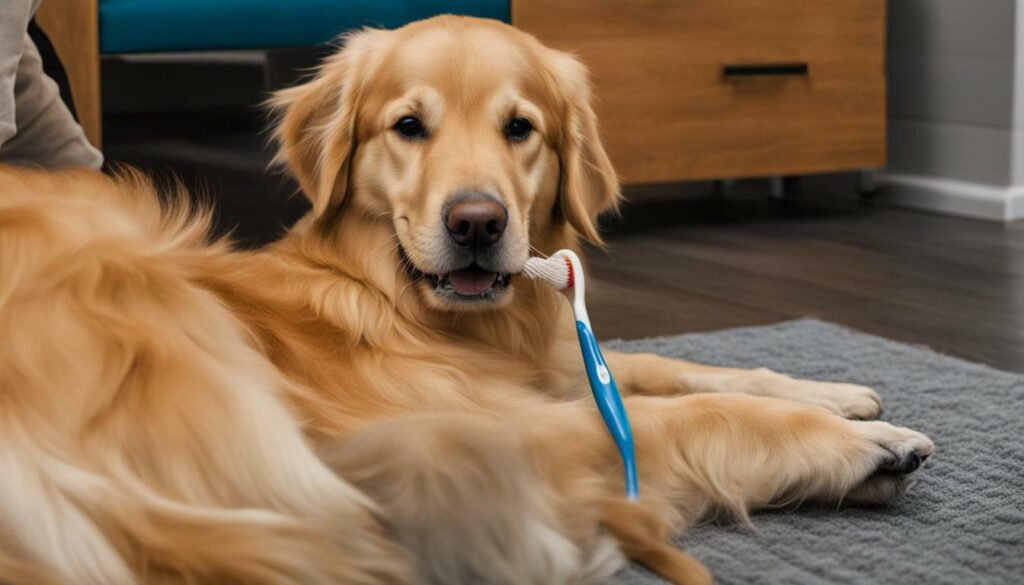
Training your dog to brush their teeth requires patience, consistency, and positive reinforcement. Positive reinforcement involves rewarding your dog for good behavior, which helps them associate toothbrushing with a positive experience. Here are some effective positive reinforcement techniques for training your dog to brush their teeth:
- Use high-value treats: Offer your dog a small, high-value treat after each toothbrushing session to reward them for their cooperation. Make sure the treats are safe for dogs and avoid overfeeding.
- Praise and petting: During toothbrushing, praise your dog for their good behavior, and reward them with a few minutes of extra attention and petting.
- Start slow: Begin by introducing your dog to the toothbrush and toothpaste without actually brushing their teeth. Reward them with treats and praise for sniffing and investigating the items.
- Nursery rhymes: Use a repetitive nursery rhyme or song during toothbrushing to create a positive association. Start singing the song when you introduce the toothbrush and toothpaste, and continue until you’ve finished brushing.
- Short sessions: Start with brief toothbrushing sessions, gradually increasing the duration as your dog becomes more comfortable with the process. This helps prevent overwhelming your dog and making them resistant to toothbrushing.
Remember to always use a gentle, calm tone of voice during the training process to avoid alarming or agitating your dog.
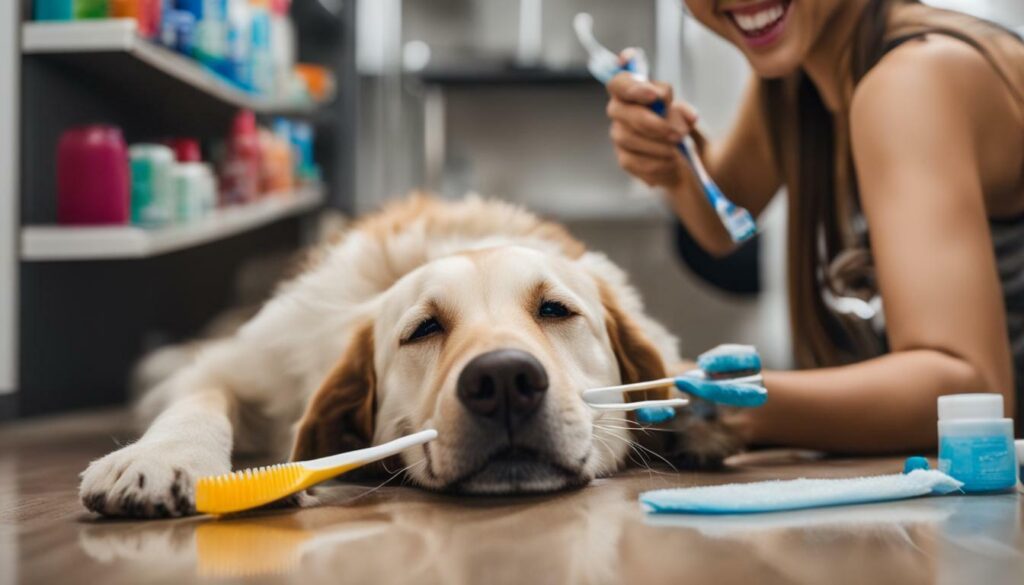
Using positive reinforcement techniques can help make toothbrushing a positive experience for both you and your dog. With patience and consistency, you can train your dog to have good dental hygiene and maintain their oral health.
Step-by-Step Toothbrushing Training Process
Now that you’ve familiarized your dog with the toothbrush and toothpaste and gotten them comfortable with toothbrush handling, it’s time to begin the toothbrushing process. Follow these simple steps to teach your dog how to brush their teeth:
- Start by gently lifting your dog’s lip, exposing their teeth. It’s essential to be patient and calm during this process to prevent your dog from becoming anxious or fearful.
- Using small circular motions, brush your dog’s teeth with the toothbrush angled at a 45-degree angle towards the gum line.
- Avoid brushing too hard, as this can cause discomfort or damage to your dog’s teeth and gums.
- Gradually increase the duration of each session, starting with just a few seconds and working up to two minutes.
- Be sure to reward your dog with positive reinforcement such as praise, treats, or playtime after each successful toothbrushing session.
- It’s essential to brush all teeth, including the hard-to-reach molars in the back of the mouth.
- Consistency is key, so continue to brush your dog’s teeth daily or as recommended by your veterinarian.
Remember to take things slow and be patient with your furry friend. With time and patience, you’ll have a dog that is comfortable with the toothbrushing process.
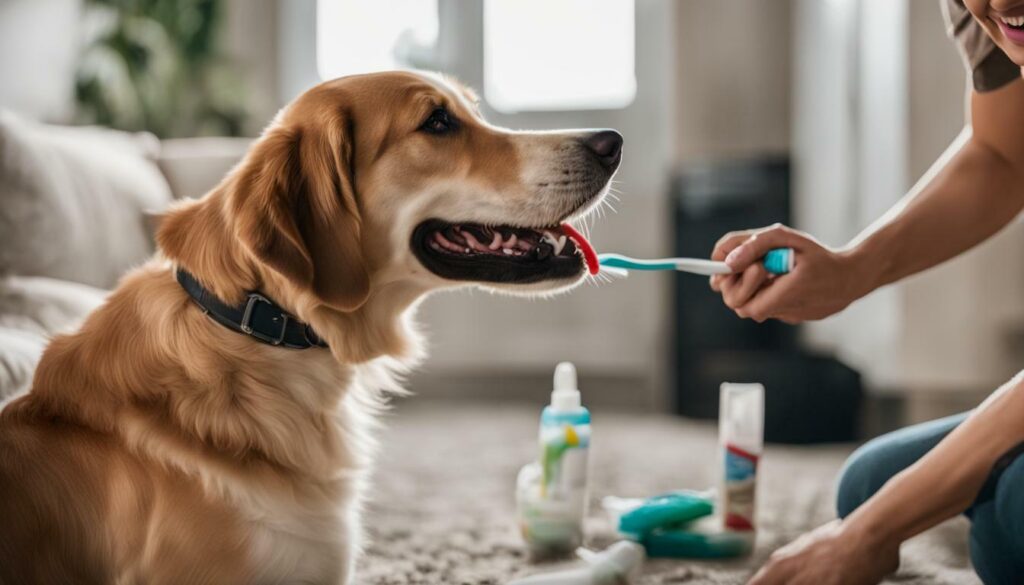
Dog owners may face various challenges when it comes to brushing their pet’s teeth. However, with careful planning and the right techniques, these challenges can be overcome, ensuring effective dental care for your dog.
Resistance: Some dogs may resist toothbrushing and struggle or even bite during the process. If your dog is resistant, start by introducing them to the toothbrush gradually. Allow them to sniff and lick the toothbrush to familiarize themselves with it. Try brushing only a few teeth at a time, gradually increasing the time and area brushed as they become more comfortable.
Fear: Fear may be another challenge when training your dog to brush their teeth. If your dog is afraid of the toothbrush, start by using a finger brush or a piece of gauze wrapped around your finger. This can help them become accustomed to the sensation of having their teeth brushed. Use plenty of positive reinforcement during the process, such as treats and praise, to help them associate toothbrushing with positive experiences.
Difficulty accessing all teeth: Accessing all of your dog’s teeth can be challenging, especially for larger breeds or those with crowded teeth. When brushing, ensure that you reach all teeth and focus on the gum line to prevent plaque buildup. If necessary, seek professional help from a veterinary dental specialist to ensure thorough dental care.
By overcoming these common challenges, you can establish a successful toothbrushing routine for your dog, promoting their dental health and overall well-being.
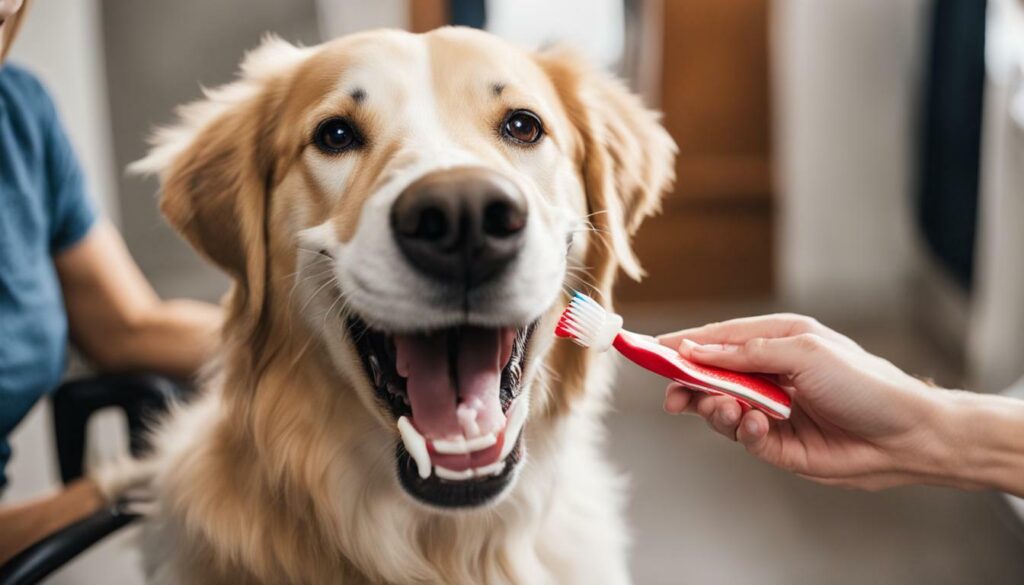
Now that you have trained your dog to brush their teeth, it is crucial to establish a consistent dental care routine. The recommended frequency for toothbrushing sessions depends on your dog’s breed, age, and oral health status. However, a general guideline is to brush your dog’s teeth at least 2-3 times a week.
It is also important to ensure that each toothbrushing session is long enough to thoroughly clean your dog’s teeth. A minimum of 2 minutes per session is recommended to remove plaque and tartar buildup effectively. Breaking the session into two 1-minute intervals with a short break in between can also increase the overall effectiveness of the toothbrushing process.
Remember that regular toothbrushing is essential to maintain your dog’s dental hygiene and prevent oral health issues. Consistency in the frequency and duration of toothbrushing sessions, combined with complementary dental care strategies, such as dental chews and oral rinses, can keep your dog’s teeth healthy and clean.
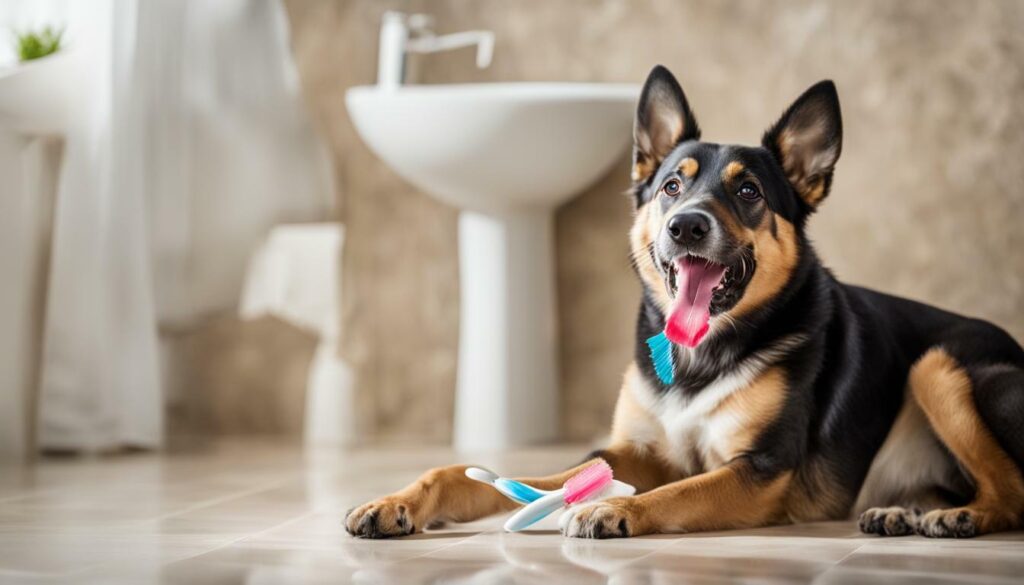
If your dog is not receptive to toothbrushing, there are alternative methods to promote dental hygiene. Although they may not be as effective as brushing, these alternatives can still contribute to maintaining your dog’s oral health.
- Dental chews: High-quality dental chews are specifically designed to clean teeth and freshen breath. Choose chews with the Veterinary Oral Health Council (VOHC) seal of approval for optimal effectiveness.
- Specific diets: Certain dog foods are formulated to promote dental health by reducing plaque and tartar buildup. Consult with your veterinarian to determine the best diet for your dog’s dental needs.
- Oral rinses: Oral rinses can help reduce bacteria in the mouth and freshen breath. Look for rinses specifically formulated for dogs and follow the instructions for proper use.
It’s important to note that these alternatives should not replace regular toothbrushing. However, they can be used in conjunction with a brushing routine to enhance your dog’s oral health.
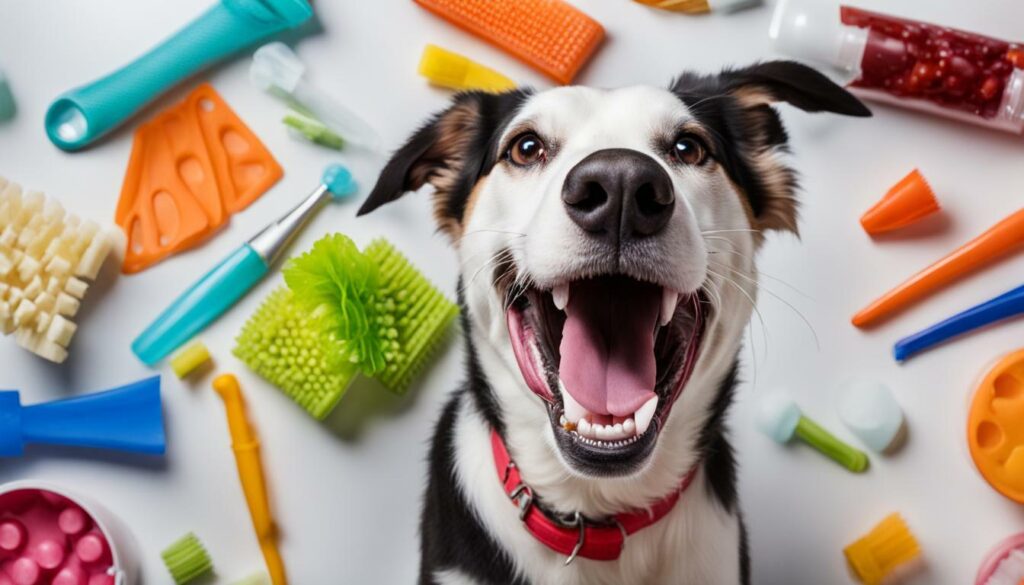
Regular dental check-ups and professional cleanings are essential components of your dog’s dental care routine. Even with daily brushing and other oral care methods, plaque and tartar can accumulate over time and lead to dental issues, such as gum disease and tooth decay. A veterinary check-up allows for early detection and treatment of these problems before they worsen.
During a dental check-up, the veterinarian will examine your dog’s teeth and gums, looking for any signs of disease or decay. They may also perform a professional cleaning known as a dental prophylaxis, which involves scaling to remove tartar and polishing to smooth the surface of the teeth. In severe cases, extractions or other treatments may be necessary.
It’s recommended that dogs receive a veterinary dental check-up at least once a year, although more frequent visits may be necessary for certain breeds or those with pre-existing dental conditions. Consult with your veterinarian to determine the appropriate schedule for your pet.
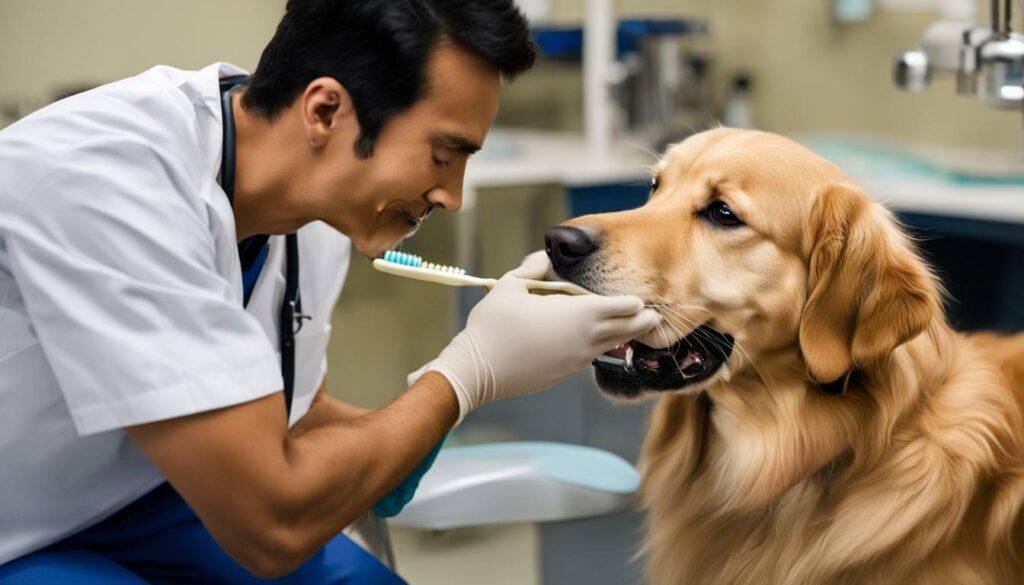
Regular dental check-ups and professional cleanings are an essential aspect of dental hygiene for dogs. By staying on top of your pet’s oral health, you can prevent dental issues and ensure their overall well-being.
Signs of Dental Problems to Look Out For
As a responsible dog owner, it’s essential to keep an eye out for potential dental problems in your furry friend. Catching these issues early on can prevent more significant health concerns down the line. Here are some signs of dental problems to watch for:
- Bad breath
- Visible tartar or plaque buildup on teeth
- Bleeding or inflamed gums
- Difficulty eating or chewing
- Loose or missing teeth
- Excessive drooling
If you notice any of these symptoms, it’s essential to consult your veterinarian. They can assess your dog’s dental health and identify any underlying issues that require treatment. Ignoring dental problems can lead to infection, pain, and even tooth loss, impacting your dog’s overall well-being.
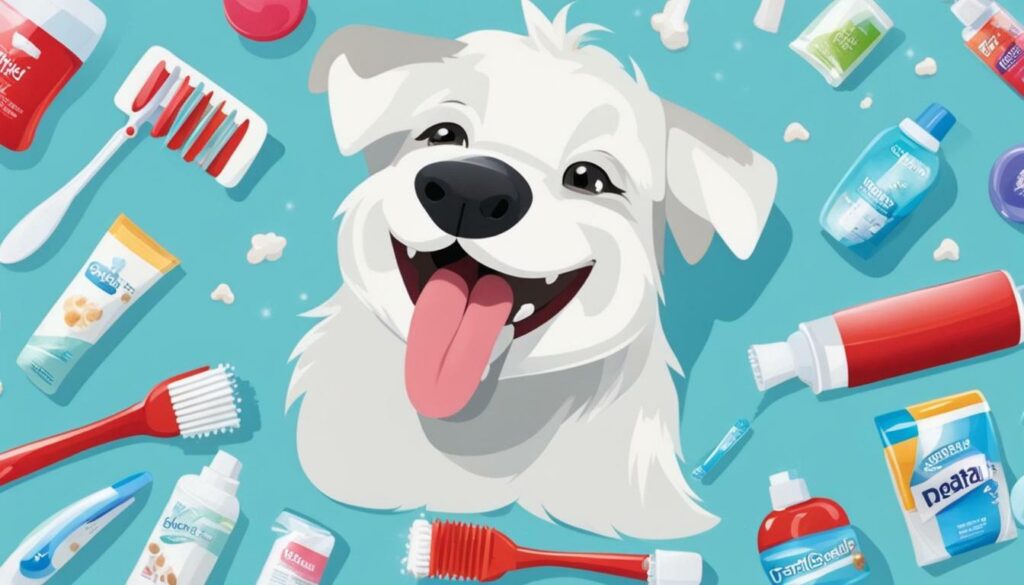
Regular toothbrushing and consistent dental care routine can help prevent dental problems from developing. However, it’s crucial to recognize the signs of dental issues and seek professional help when necessary. Stay vigilant and proactive about your dog’s dental hygiene to keep them healthy and happy for years to come.
13. Maintaining Dental Hygiene at Home
Teaching your dog to brush their teeth is an essential component of maintaining their dental hygiene, but there are other strategies you can implement to supplement your brushing routine.
One effective method is providing your dog with dental chews. Dental chews are specifically designed to reduce plaque and tartar buildup while freshening your dog’s breath. Opt for high-quality dental chews, ideally with the Veterinary Oral Health Council (VOHC) seal of approval. It is also important to monitor your dog when they are chewing to ensure they do not swallow large pieces that can cause choking or other digestive issues.
Another way to maintain your dog’s dental hygiene is through their diet. Certain diets, such as those with crunchy kibbles or specialized dental formulas, can help scrape away plaque and tartar. However, it is important to consult with your veterinarian to determine the best diet option for your dog’s specific needs.
Oral rinses can also be beneficial in maintaining your dog’s dental health. Similar to mouthwash for humans, oral rinses can help freshen breath and reduce the buildup of harmful bacteria in your dog’s mouth. Look for oral rinses formulated specifically for dogs and follow the manufacturer’s instructions for safe and effective use.
By incorporating dental chews, diet, and oral rinses into your dog’s dental care routine, you can enhance the effectiveness of your teeth brushing training and maintain your dog’s oral health in between brushing sessions.
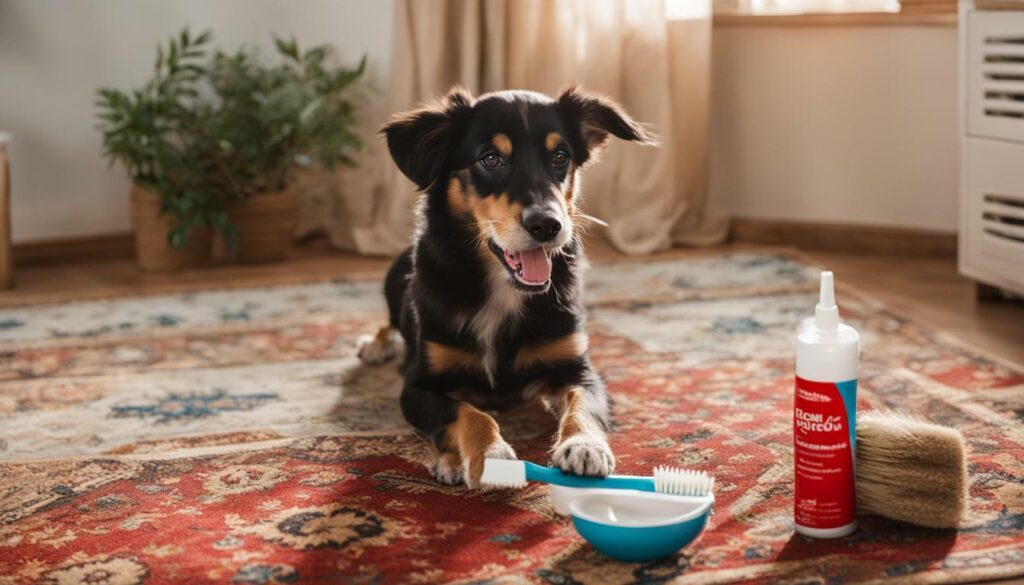
Remember that consistency is key in maintaining your dog’s dental hygiene. By adhering to a regular schedule of toothbrushing and supplementing with other dental care strategies, you can prevent oral health issues and ensure your dog’s overall well-being.
Importance of Consistency in Dental Care Routine
Creating a consistent dental care routine is crucial in maintaining your dog’s oral health. Brushing their teeth regularly, along with other dental care activities, can help prevent various dental issues and maintain their overall well-being. Consistency in dental care also teaches your dog good habits and strengthens your bond with them.
When creating a dental care routine, ensure that it is feasible and realistic for both you and your dog. Start with short brushing sessions and gradually increase their duration over time. Determine the optimal frequency of brushing sessions by consulting with your veterinarian.
Incorporate positive reinforcement techniques, such as rewarding your dog with treats and praise, into your dental care routine. This helps to create a positive association with toothbrushing and makes the process more enjoyable for your furry friend.
Other ways to maintain dental hygiene include providing your dog with dental chews and incorporating specific diets into their meal plan. Oral rinses may also be used to complement your brushing routine.
Remember, consistency is key in maintaining your dog’s oral health. By creating a regular dental care routine and consistently implementing it, you can prevent dental issues and ensure the longevity of your dog’s healthy smile.
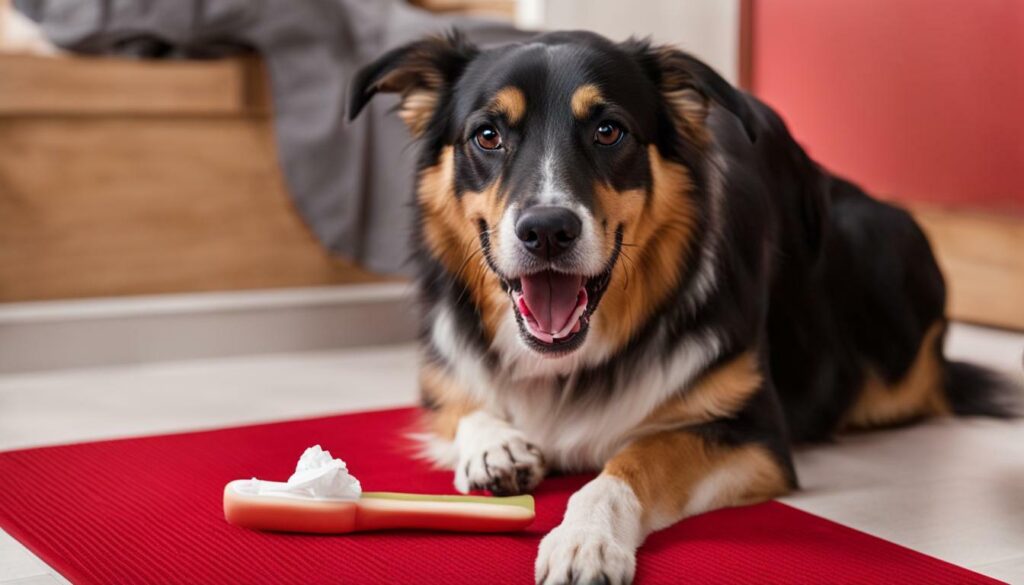
Troubleshooting and Seeking Professional Help
Despite following the training process, some dogs may still exhibit resistance or difficulty with toothbrushing. If you encounter any challenges, do not give up! Instead, employ troubleshooting techniques to address the issue.
One common challenge is fear or anxiety associated with toothbrushing. In such cases, you can try desensitization techniques, gradually introducing the toothbrush and rewarding positive behavior. Alternatively, you can explore alternative dental care options, as discussed in section 10.
If your dog’s dental health worsens or you notice any signs of dental problems, seek professional help from a veterinarian. A veterinary dental specialist can diagnose and treat dental issues, ensuring your dog’s continued oral health.
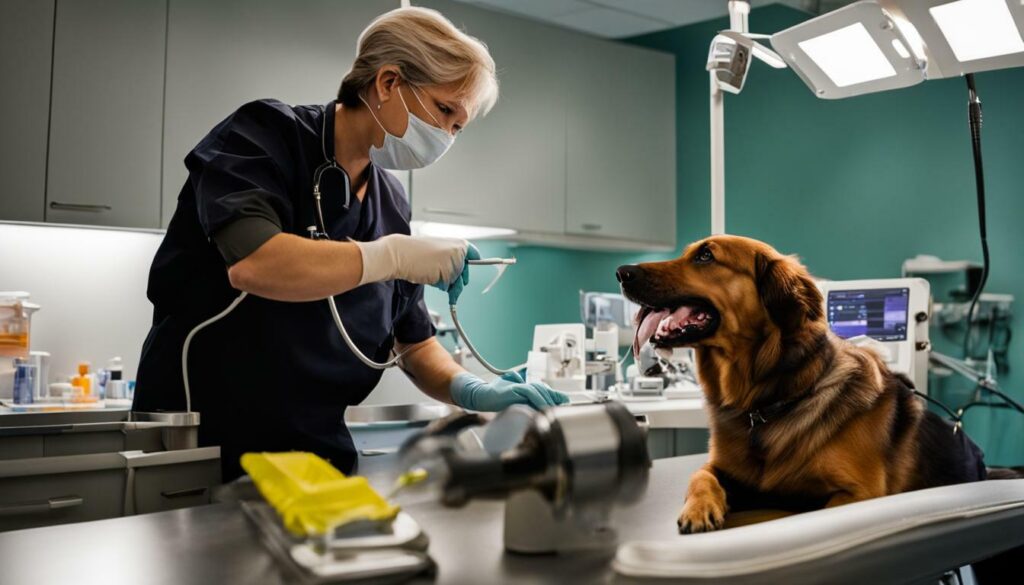
Regular dental check-ups are essential in maintaining your dog’s oral health. By catching and addressing any issues early, you can prevent more severe dental problems and ensure your dog’s overall well-being. Additionally, a professional cleaning can remove any excess tartar buildup, which can be difficult to remove with at-home care.
Remember, maintaining your dog’s dental hygiene requires consistency and effort. By following the techniques outlined in this guide and seeking professional help when necessary, you can enhance your dog’s dental health and contribute to their overall happiness and well-being.
Conclusion: Enhancing Your Dog’s Dental Health
Maintaining your dog’s dental health is crucial for their overall well-being. By following our step-by-step training process on how to train your dog to brush their teeth, you can help prevent dental issues that can lead to pain, discomfort, and costly veterinary bills.
Remember to choose the appropriate toothbrush and toothpaste, introduce your dog to toothbrushing gradually, implement positive reinforcement techniques, and overcome common challenges in toothbrushing.
Consistency is key, so establish a regular dental care routine and complement it with other methods such as dental chews, specific diets, and oral rinses.
If you notice any signs of dental problems in your dog, such as bad breath, red or inflamed gums, or difficulty eating, seek professional help from a veterinarian. Regular dental check-ups and professional cleanings are also essential in preventing dental issues.
Enhancing your dog’s dental health requires commitment and effort, but the rewards are well worth it. Follow these tips and techniques to help your furry friend maintain a healthy, happy smile.
FAQ
Why is dental hygiene important for dogs?
Dental hygiene is important for dogs because poor oral care can lead to health issues. Implementing a dental care routine can prevent dental disease and promote overall well-being.
How do I introduce my dog to toothbrushing?
You can introduce your dog to toothbrushing by familiarizing them with the toothbrush and creating positive associations. Take it slow and reward them for their cooperation.
What toothbrush and toothpaste should I use for my dog?
Choose a toothbrush specifically designed for dogs and use toothpaste formulated for canine dental care. There are various options available, so find the ones that work best for your dog.
How can I get my dog comfortable with toothbrush handling?
Dogs may be resistant to having their teeth brushed at first. Use patience and positive reinforcement techniques to acclimate your dog to toothbrush handling and make it a more comfortable experience.
What are some positive reinforcement techniques for training?
Positive reinforcement is key to successful training. Use treats, praise, and rewards to encourage your dog during the toothbrushing process and make it an enjoyable experience.
What is the step-by-step toothbrushing training process?
Follow our step-by-step training process to teach your dog how to brush their teeth. From introductions to gradually incorporating brushing motions, we’ll guide you through each stage.
What challenges might I face when brushing my dog’s teeth?
Many dog owners face challenges when it comes to brushing their pet’s teeth. Learn how to overcome common hurdles such as resistance, fear, and difficulty accessing all teeth for thorough dental care.
How often and how long should I brush my dog’s teeth?
Brush your dog’s teeth regularly, ideally daily or at least several times a week. Aim for a duration of 2-3 minutes per brushing session to ensure thorough cleaning.
Are there alternatives to toothbrushing for dental care?
If your dog is not receptive to toothbrushing, there are alternative methods to promote dental hygiene. Explore options such as dental chews, specific diets, and oral rinses to complement your brushing routine.
Why are regular dental check-ups and professional cleanings important?
Regular dental check-ups and professional cleanings are crucial for your dog’s dental health. These visits help prevent dental issues and ensure your dog’s overall well-being.
What are the signs of dental problems in dogs?
Be aware of signs and symptoms indicating potential dental problems in your dog. Look out for bad breath, swollen gums, tooth discoloration, and difficulty chewing.
How can I maintain my dog’s dental hygiene at home?
In addition to toothbrushing, there are other ways to maintain your dog’s dental hygiene at home. Explore strategies such as dental chews, specific diets, and oral rinses to complement your brushing routine.
Why is consistency important in a dental care routine?
Consistency is key when it comes to your dog’s dental care routine. Maintaining a regular schedule and reinforcing good dental habits is vital for preventing oral health issues.
What should I do if I encounter difficulties or my dog’s dental health deteriorates?
If you encounter difficulties or notice your dog’s dental health worsening, seek professional help from a veterinarian. They can provide guidance and, if necessary, refer you to a veterinary dental specialist.
What are the key takeaways for enhancing my dog’s dental health?
The key takeaways for enhancing your dog’s dental health include introducing toothbrushing gradually, using positive reinforcement techniques, and maintaining a consistent dental care routine.
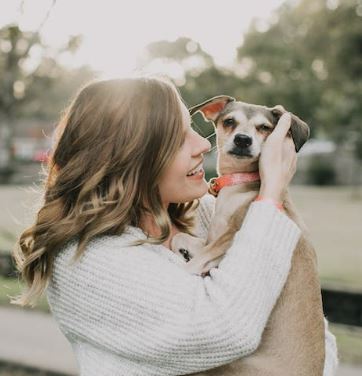
Marissa Delotta, 36, from Dayton, Ohio, is the creative force behind Roverboard.com, a beloved online destination for dog lovers. As a dedicated mom and canine enthusiast, Marissa combines her family experiences with her love for dogs to offer a platform where dog owners can exchange tips, heartwarming stories, and advice. Her website has become a vibrant community for sharing the joys of dog parenting. In her free time, Marissa enjoys exploring dog parks with her family and volunteering at local animal shelters.